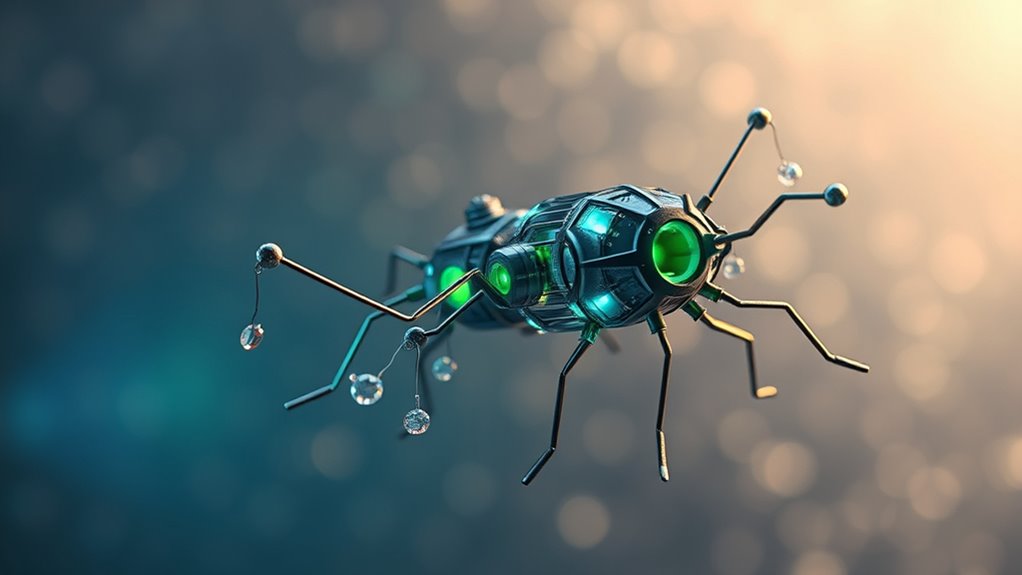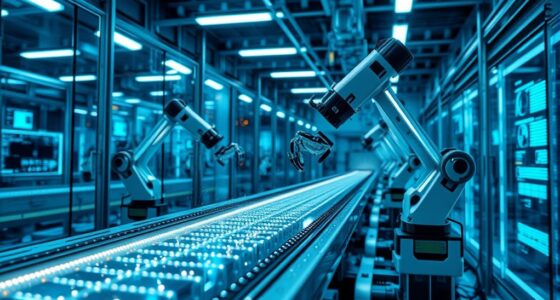Nanomachines are tiny devices designed to capture and remove CO₂ from the atmosphere, offering a promising way to fight climate change. They use special materials and optimized shapes to maximize reactive surface area, making them highly efficient at binding carbon molecules. These devices can be engineered to operate continuously and safely, with cost-effective and eco-friendly methods. To find out how these innovations could make a big difference, keep exploring.
Key Takeaways
- Nanomachines are tiny devices designed to efficiently capture and remove atmospheric CO₂, aiding climate change mitigation.
- They utilize high-affinity materials and optimized structures to maximize reactive surface area for CO₂ binding.
- Incorporating catalytic surfaces facilitates chemical conversion and enhances the sequestration process.
- Development focuses on creating environmentally safe, cost-effective, and self-regenerating nanomachines for large-scale use.
- Advancements in nanomachine technology aim to significantly reduce atmospheric CO₂ levels and combat global climate change.

As global carbon emissions continue to rise, scientists are turning to innovative solutions like nanomachines to combat climate change. These tiny devices, often only a few nanometers in size, hold the potential to revolutionize how we capture and remove CO₂ from the atmosphere. Central to this effort is nanomachine design, which focuses on creating highly effective structures capable of efficiently binding carbon molecules. When optimized, nanomachine design directly impacts capture efficiency, determining how much CO₂ each nanomachine can sequester over a given period. To maximize capture efficiency, researchers prioritize materials with high affinity for CO₂, such as metal-organic frameworks or specialized polymer coatings, integrated into the nanomachine’s architecture. The shape and surface area of these machines are also critical factors—they need to present as much reactive surface as possible to the surrounding air to enhance their ability to grab onto CO₂ molecules swiftly.
You’ll find that engineers are experimenting with different configurations to improve how these nanomachines operate in real-world conditions. For example, some designs incorporate catalytic surfaces that facilitate the chemical conversion of CO₂ into less harmful substances, making the process more efficient and sustainable. Others focus on developing self-regenerating nanomachines that can release captured CO₂ when exposed to specific stimuli like temperature changes or chemical triggers, allowing for continuous operation with minimal maintenance. The challenge lies in balancing the nanomachine’s capture efficiency with its stability, energy requirements, and scalability. Higher capture efficiency means more CO₂ removal per unit, but if the nanomachines are too delicate or require excessive energy, they may not be practical for large-scale deployment.
You should also consider the environmental impact and cost-effectiveness of these nanomachines. While promising, designing nanomachines that are both highly efficient and environmentally benign demands meticulous planning. The fabrication processes must be scalable without exorbitant costs, and the materials used should not pose ecological risks. Continuous advancements in nanomaterial synthesis and molecular engineering are helping overcome these hurdles, enabling the development of nanomachines that are more robust, efficient, and affordable. Moreover, understanding the AI Security challenges related to deploying such advanced technologies is increasingly important as AI systems are integrated into environmental solutions. As you explore this field, understanding the nuances of nanomachine design and how it influences capture efficiency is critical. These innovations could eventually lead to widespread deployment, markedly reducing atmospheric CO₂ levels and helping mitigate climate change’s worst impacts.
Frequently Asked Questions
What Are the Potential Environmental Impacts of Nanomachine Deployment?
You might face ecological disruption if nanomachines malfunction or are improperly managed. As they operate, there’s a risk of nanoparticle accumulation in ecosystems, which could harm aquatic and terrestrial life. Deployment could also lead to unforeseen environmental consequences, such as disrupting natural processes or contaminating soil and water sources. Proper regulation and careful monitoring are essential to mitigate these risks and ensure that nanomachine use remains environmentally safe.
How Cost-Effective Are Nanomachines Compared to Traditional Capture Methods?
Think of nanomachines as tiny treasure hunters searching for carbon, and traditional methods as large, slow ships. You’ll find nanomachines more cost-effective over time because their manufacturing costs decrease with innovation, boosting economic feasibility. While initial expenses might be high, their precision and efficiency can lower operational costs. So, compared to traditional methods, nanomachines have the potential to be a smarter, more economical choice for carbon capture.
What Are the Safety Protocols for Handling Nanomachines?
You should follow strict safety regulation guidelines to handle nanomachines safely. This includes proper nanomachine containment procedures to prevent accidental release or exposure. Always wear protective gear, work in controlled environments, and regularly inspect equipment. Stay updated on safety protocols, and confirm training on nanomachine handling. Proper containment and adherence to safety regulation minimize risks, safeguarding both you and the environment from potential hazards associated with nanomachine use.
Can Nanomachines Target Specific Types of Carbon Emissions?
You might worry that nanomachines can’t be precise, but they’re designed for selective targeting, making emission specificity a real possibility. These tiny devices can be programmed to identify and capture specific carbon emissions, like methane or industrial CO2, while ignoring other gases. This precision guarantees more efficient capture processes and less environmental impact, proving that nanomachines can indeed target particular emissions effectively and safely.
How Scalable Is Nanomachine Technology for Global Carbon Reduction?
You might find that nanomachine technology faces significant scalability challenges due to manufacturing limitations. Producing enough nanomachines to impact global carbon reduction is complex and costly. While advancements are promising, scaling up requires overcoming these hurdles, ensuring efficient mass production, and maintaining quality. Although promising, widespread deployment still needs substantial innovation and investment to become a practical solution for global carbon capture.
Conclusion
By harnessing nanomachines, you could reduce global carbon emissions by up to 90% in the coming decades. These tiny devices promise a revolutionary way to combat climate change, making carbon capture more efficient and affordable. Imagine a future where your efforts to protect the planet are amplified by cutting-edge technology working tirelessly at the atomic level. With such promising advancements, it’s clear nanomachines could be the game-changer our world desperately needs.









